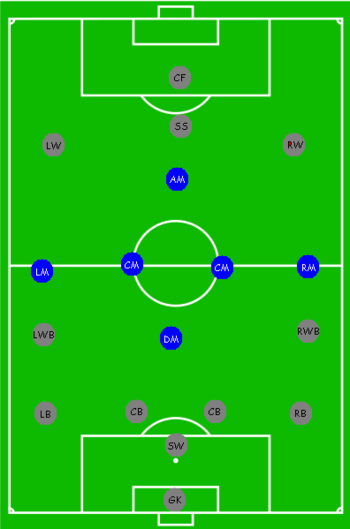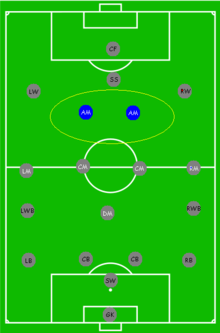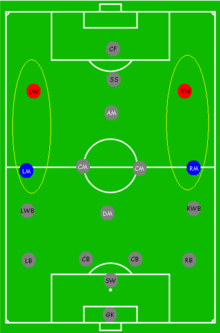- Midfielder
-
For other uses, see Midfielder (disambiguation).
A midfielder (or simply mid) is an association football position.[1] Some midfielders play a more defensive role, while others blur the boundaries between midfielders and forwards.[2] The number of midfielders a team uses during a match may vary, depending on the team's formation and each individual player's role. The group of midfielders in a team is called the midfield.
More complete midfielders require a number of skills on top of fitness: they tackle, dribble, shoot and pass during any match. Most managers field at least one central midfielder with a marked task of breaking up opposition's attacks while the rest are more adept to creating goals or have equal responsibilities between attack and defence. At either side of the pitch a manager can field a right or left midfielder, who are used equally for both attack and defence, or a winger, a player used primarily for attack.
In essence, a good midfield must possess the ability to be combative while also being creative. A good striker without midfield support could lack attacking chances, while a defense likewise could be severely tested. Because they occupy the most influential parts of the pitch, midfielders are perhaps more likely to influence the outcome of a match than other positions,[3] especially if they have vision for a good pass or ability to score.
Midfielders typically expend the most energy during a match because of the distance they cover on a pitch, as at times they can be called back into defence, or required to attack with the strikers.[1]
Contents
Centre midfielder
Centre midfielders play several roles on the field of play, and are probably the most important in terms of setting up attacks. Their position enables them to have an all-round view of the match, and as most of the action takes place in and around their area of the pitch, midfielders often exert the greatest degree of control over how a match is played. This section of the field is often known as a team's "engine room", because great teams rarely succeed without skillful, commanding central midfielders.
Defensive midfielder
A defensive midfielder or holding midfielder is often likened to an evolved version of the old-school sweeper.
The responsibilities of defensive midfielders usually include:
- Screening the defense by harrying and tackling the opposition teams' attackers and defenders.
- Covering the positions of full-backs, midfielders and even centre-backs as they advance into attack. This can be during open play or during set pieces such as free-kicks or corners.
- Retaining distribution nearer the defense. As passing square across the defense can be especially risky, the presence of the defensive midfielder just in front of defenders provides a relatively safer option going forward.
- Directing the distribution towards the flanks or further up front.
- Directing the opposition distribution to the flanks or deeper down their end, where they are less effective. Defensive midfielders are often pulled slightly towards the flank to deal with the threat of wingers cutting infield.
Although the duties of defensive midfielders are primarily defensive, some midfielders are deployed as deep-lying playmakers, due to their ability to dictate tempo from a deep position with their passing. As they are not defensive specialists, they are typically supported by a more defensive holding midfielder.
Defensive midfielders require excellent positional sense, work rate, tackling ability, and anticipation (of player and ball movement) to excel. They also need to possess excellent passing skills and close control to hold the ball in midfield under sustained pressure. Most importantly, defensive midfielders require great stamina as they are the onfield players who cover the greatest distance during a professional football match. Deep-lying playmakers typically require a good first touch under opposition pressure and the ability to play long crossfield passes to attacking players further upfield.
The defensive midfielder position is also referred to in Brazilian Portuguese as volante and in South American Spanish as volante de marca (Spanish and Portuguese for "steering wheel", or someone who gives direction), in Portugal as a trinco (meaning "lock"), in Mexico as "volante de contención" and in Russian as a волнорез (pronounced – vol-no-rez, meaning "breakwater"). Most Brazilian teams deploy at least one "volante" in their team, including the Brazilian national team who have fielded defensive midfielders, such as 1994 World Cup winning team captain Dunga.
Deep-lying playmaker
Some players prefer to set up an attack from a withdrawn position, and are often coined deep-lying playmakers, mainly because of their ability to spread play and dictate the game from a withdrawn position. Despite their deep role, they are not classed as defensive midfielders as tackling and defence are not the main function of their roles, and they may have to be supported by a holding midfielder.
Deep-lying playmakers are typically given a moderate amount of defensive responsibilities, but are granted freedom positionally to dictate the play as it evolves, as well as a license to attempt long, riskier balls, to the forwards.
The essential attributes of a deep-lying playmaker include:
- Good long passing ability, to play balls towards forwards and wingers. Crossfield passes are typically attempted from deep when the opposing full back is drawn towards the middle and there is an open channel in the flank for the on rushing winger.
- Stamina, to cover large distances in professional football. In the top football leagues, a midfielder covers upwards of 10 kilometres per game.
- Short passing ability. Although many deep-lying playmakers have natural talent and creativity, they are expected to play short simple passes when deep in their half to avoid the possibility of a counter-attack. They are however given some degree of freedom in playing long passes deep into opposition territory.
- Creativity/Vision. The deep-lying playmaker needs to spot openings and opportunities to build up play.
- A good and sure first touch to control the ball when receiving passes under sustained opposition pressure.
Attacking midfielder
An attacking midfielder is any midfielder who is stationed in a more advanced midfield position to assist goalscoring.[3] The attacking midfielder is an influential position and requires the player to possess good technical abilities, an eye for a pass, shooting, running, and dribbling skills.
Attacking midfielders are generally required to have:
- Excellent technical ability, including close control, passing, shooting and dribbling.
- Creativity, to anticipate passing opportunities for their fellow forwards.
- Off-the-ball intelligence, to anticipate passes from the midfield which create opportunities to score or to pass on to a forward.
- An understanding of the winger role. Due to tactical changes, central attacking midfielders are sometimes played on the wing, to accommodate other strikers or forwards.
- A secondary ability is finishing ability and composure.
Playing in a very advanced central midfield role just behind the strikers is sometimes known as "playing in the hole", although this term can also be used to describe a deep lying forward, traditionally he/she is called a trequartista. This specialist midfielder's main role is to act as the offensive pivot of the team, to create goal-scoring opportunities for his team mates, and perhaps to score himself. This position is also known as playmaker.[2]
The attacking midfielder position is also referred to in Brazilian Portuguese as meia' or 'meia-atacante' ("attacking midfielder" in English).
Box-to-box midfielder
The term "box-to-box" is often used to refer to the most dynamic all-round/complete midfielders, who provide both defensive and attacking prowess.[4] The most versatile of players, they typically possess exceptional stamina and are usually skilled at tackling, passing, shooting and also good at keeping possession.
Winger
A winger or wide midfielder is a midfielder located on the wing of the midfield. Traditionally, wingers were purely attacking players who hugged the touch line and were not expected to track back and defend. This began to change in the 1960s. In the 1966 World Cup, England manager Alf Ramsey did not select wingers from the quarter final onwards. This team was known as the "Wingless Wonders" and led to the modern 4–4–2 formation.[5][6]
This has led to most modern wide players having a more demanding role in the sense that they are expected to provide defensive cover for their full-backs and track back to repossess the ball, as well as provide skillful crosses for centre forwards and strikers.[7] Some forwards are able to operate as wingers behind a lone striker. In a three-man midfield, specialist wingers are sometimes deployed down the flanks alongside the central midfielder or playmaker.
Even more demanding is the role of wing-back, where the wide player is expected to provide both defence and attack.[8] As the role of winger can be classed as a forward or a midfielder, so this role blurs the divide between defender and midfielder.
A winger is an attacking midfielder who is stationed in a wide position near the touchlines.[7] Wingers such as Stanley Matthews or Jimmy Johnstone used to be classified as forwards in traditional W-shaped formations, and were formally known as "Outside Right" or "Outside Left", but as tactics evolved through the last 40 years, wingers have dropped to deeper field positions and are now usually classified as part of the midfield, usually in 4–4–2 or 4–5–1 formations (but while the team is on the attack, they tend to resemble 4–2–4 and 4–3–3 formations respectively).
The responsibilities of the winger include:
- Providing a "wide presence" as a passing option on the flank.
- To beat the opposing full-back either with skill or with speed.
- To read passes from the midfield that give them a clear crossing opportunity, when going wide, or that give them a clear scoring opportunity, when cutting inside towards goal.
- To double up on the opposition winger, particularly when he is being "double-marked" by both the team's full back and winger.
The stereotypical winger is fast, tricky and enjoys 'hugging' the touchline, that is, running downfield close to the touchline and delivering crosses. However, players with different attributes can thrive on the wing as well. Some wingers prefer to cut infield (as opposed to staying wide) and pose a threat as playmakers by playing diagonal passes to forwards or taking a shot at goal. Even players who are not considered quick, have been successfully fielded as wingers at club and international level for their ability to create play from the flank. Occasionally wingers are given a free role to roam across the front line and are relieved of defensive responsibilities.
The typical abilities of wingers include:
- Technical skill to beat a full-back in a one-to-one situation.
- Pace, to beat the full-back one-on-one.
- Crossing ability when out wide.
- Good off-the-ball ability when reading a pass from the midfield or from fellow attackers.
- Good passing ability and composure, to retain possession while in opposition territory.
- The modern winger should also be comfortable on either wing so as to adapt to quick tactical changes required by the coach.
Traditionally, right-footed players are played on the right wing and left-footed players on the left as a matter of familiarity and comfort. However, in the modern game, coaches usually demand wingers to be able to play on both flanks and to switch flanks during play regularly as a quick change of tactics. For instance, a right-footed winger who plays on the left flank is more comfortable cutting into the middle, which suits the styles of playmaker forwards who can cause a threat both by shooting from distance, dribbling towards goal, or sliding through passes to other forwards. Another advantage is that the winger can cut inside, towards the weaker foot of the full-back. Clubs such as Barcelona and Real Madrid often choose to play their wingers on the 'wrong' flank for this reason; Barcelona's Josep Guardiola puts left-footed Lionel Messi on the right and Pedro on the left, while Real Madrid's coach Jose Mourinho often plays Ángel di María on the right and Cristiano Ronaldo on the left. One of the foremost practitioners of playing from either flank was the German winger, Jürgen Grabowski, whose flexibility helped Germany to fourth place in the 1970 World Cup, and a championship in the 1974 World Cup.
Although wingers are a familiar part of football, the use of wingers is by no means universal. There are many successful football teams who operate without wingers. A famous example is AC Milan, who typically play in a narrow midfield diamond formation or in a Christmas tree formation (4–3–2–1), relying on full-backs to provide the necessary width down the wings.
See also
- Association football positions
- Formation
- Forward
- Outside forward
- Defender
- Goalkeeper
- Playmaker
References
- ^ a b "Positions guide: Central midfield". London: BBC Sport. 2005-09-01. http://news.bbc.co.uk/sport1/hi/football/rules_and_equipment/4197190.stm. Retrieved 2008-.
- ^ a b "Football / Soccer Positions". Expert Football. http://expertfootball.com/coaching/positions.php. Retrieved 2008-06-21.
- ^ a b "Positions in football". talkfootball.co.uk. http://www.talkfootball.co.uk/guides/positions_in_football.html. Retrieved 2008-06-21.
- ^ "Box to box Bowyer". London: BBC Sport. 2002-04-29. http://news.bbc.co.uk/sport1/hi/football/1957308.stm. Retrieved 2008-06-21.
- ^ Galvin, Robert. "Sir Alf Ramsey". nationalfootballmuseum.com. http://www.nationalfootballmuseum.com/pages/fame/Inductees/siralframsey.htm. Retrieved 2008-06-21.
- ^ "Chelsea prayers fly to the wings". FIFA. 2006-03-05. http://www.fifa.com/tournaments/archive/tournament=107/edition=248388/news/newsid=103183.html. Retrieved 2008-06-25.
- ^ a b "Positions guide: Wide midfield". London: BBC Sport. 2005-09-01. http://news.bbc.co.uk/sport1/hi/football/rules_and_equipment/4197228.stm. Retrieved 2008-06-21.
- ^ "Positions guide: Wing-back". London: BBC Sport. 2005-09-01. http://news.bbc.co.uk/sport1/hi/football/rules_and_equipment/4197076.stm. Retrieved 2008-06-21.
Players MidfielderForwardCentre forward · Striker · Second striker · WingerNon-players Formation · Category Categories:- Association football midfielders
- Association football positions
- Association football terminology
Wikimedia Foundation. 2010.




